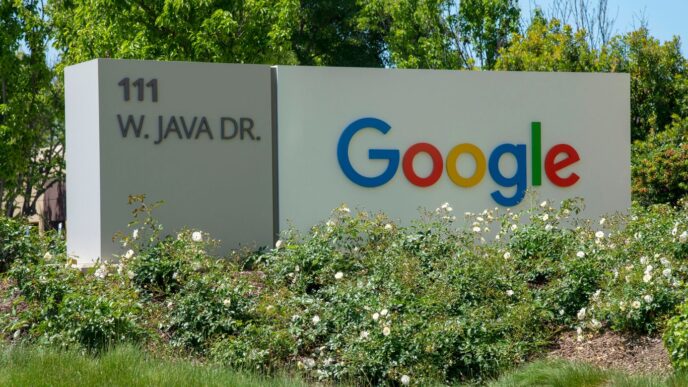Anthony Ha from TechCrunch has been sharing some really interesting thoughts lately, especially about how technology is changing. He’s been talking about big shifts in AI, the way we create and consume content, and how platforms like Beehiiv are helping people build their own media businesses. It’s a lot to take in, but he breaks it down in a way that makes sense, even for us regular folks trying to keep up.
Key Takeaways
- Data centers are becoming incredibly important, almost like the new oil fields, with massive global spending expected. This raises questions about the environmental cost and who should pay for this big tech infrastructure.
- The world of content creation is changing fast. People are moving away from big media outlets to follow individual creators, and platforms are emerging to support this shift.
- Beehiiv is positioning itself as the ‘operating system’ for this new content economy, serving everyone from individual writers to large publishers like TechCrunch and Time.
- The digital content space is getting more spread out across different platforms, which might actually create more opportunities for creators instead of just relying on one big social network.
- Even though it feels crowded, quality content still stands out. Beehiiv’s business model focuses on not taking a cut of creators’ revenue, aiming to help them grow and succeed long-term.
Anthony Ha Discusses The Shifting Landscape Of AI And Data Centers
It seems like everywhere you look these days, there’s talk about AI. And with all this AI development comes a massive need for power, which means data centers are popping up everywhere. Anthony Ha, speaking on TechCrunch’s Equity podcast, pointed out something pretty striking: global spending on AI data centers in 2025 is projected to hit $580 billion. That’s actually more than what’s expected to be spent on new oil supplies. It really makes you think – are these data centers the new oil fields? But it’s not just about the money; it’s also about where all that power comes from.
Data Centers Emerge As The New Oil Fields
This shift in spending is pretty significant. We’re talking about a huge amount of money flowing into building and powering these massive computing hubs. It’s like a gold rush, but for silicon and electricity. Companies are pouring billions into creating the infrastructure needed to train and run AI models. This isn’t just a small trend; it’s a major economic force reshaping industries and demanding vast amounts of energy.
The Environmental Impact Of AI Infrastructure
All this power consumption has a big environmental footprint. Building and running these data centers requires a lot of electricity, and that often means relying on fossil fuels, at least for now. Some companies are trying to get ahead of this by making long-term commitments to buy power from new renewable energy plants. Meta, for example, is looking into trading electricity itself to help secure power for its growing data center needs. They’re even asking for federal approval to do so, which shows how serious they are about powering their AI ambitions. It’s a complex problem: how do we fuel this AI revolution without causing more harm to the planet?
Taxpayer Funding For Big Tech’s Ambitions
There’s also a question about who should be paying for all this. Some discussions have touched on whether taxpayer money, through things like government incentives or subsidies, should be used to support the massive infrastructure projects that Big Tech companies are undertaking for their AI efforts. It’s a debate about public funds and private enterprise, especially when these companies are already generating huge profits. Should the public help foot the bill for the hardware that powers the next wave of technology? It’s a complicated issue with a lot of different angles to consider.
Insights From TechCrunch’s Equity Podcast
The TechCrunch Equity podcast crew, including Anthony Ha, recently dug into some big topics shaping the tech world. One of the most striking points was the idea that data centers are becoming the new oil fields. We’re talking about massive global spending in 2025, projected to hit $580 billion, which actually surpasses the investment in new oil supplies. It really makes you think about where our resources and focus are heading.
The Anti-AI Disclaimer From Pluribus
It sounds like there was a bit of a moment on the podcast where the discussion touched on Pluribus and their rather unique "anti-AI disclaimer." While the details weren’t fully elaborated in the provided text, it suggests a company taking a stand or at least acknowledging the complex feelings around artificial intelligence. It’s a curious angle, especially when AI is such a hot topic, and it makes you wonder what their specific concerns or messaging might be.
Wonderful’s Massive Series A For AI Agents
Israeli startup Wonderful managed to snag a huge $100 million Series A funding round. The buzz around this is that customer service could be the killer app for AI agents. Think about it – AI handling customer queries, resolving issues, and generally making things smoother. It’s a practical application that could really change how businesses interact with their customers. This kind of investment shows a lot of confidence in that specific use case for AI.
Einride’s SPAC Deal And Autonomous Vehicle Dreams
Einride, a company focused on electric trucks, is making moves with a SPAC deal. This brings the whole world of special purpose acquisition companies back into the spotlight. The big question is whether their electric truck business can actually carry the weight of their autonomous pod ambitions. It’s a bold play, combining two major trends – electrification and autonomy – and the podcast likely explored the challenges and potential of this dual approach. It’s a lot to bet on, for sure.
The Evolving Creator Economy And Media Landscape
It feels like we’re living through a pretty wild time for how people get their information and entertainment. Remember when a few big names pretty much controlled everything? That’s changing, and fast. We’re seeing a real shift where individuals can build their own platforms and reach audiences directly. It’s like the power is moving from big institutions to everyday creators.
Arming The Rebels Of Digital Content
This idea of "arming the rebels" really hits home. It’s about giving people the tools they need to break away from traditional media gatekeepers. Think about journalists who used to work for big papers or news sites. Now, many of them are striking out on their own, using their established personal brands and audience trust to launch independent ventures. They’ve got the skills, they know their niche, and with platforms like Beehiiv, they have the infrastructure to make it work. It’s not just about making a living; it’s about building something sustainable outside the old system.
Democratization Of Information Through Content Creation
What’s really interesting is how this is leading to a broader spread of information. Anyone with a good idea and the drive to create content can now find an audience. We’re not just talking about the big players anymore. Small creators covering niche topics, like electric vehicles or specific areas of tech, are building successful businesses. They’re not relying on old advertising models either. Instead, they’re using things like paid subscriptions, community features, and selling digital products. It’s a more direct connection with their audience, and it means more diverse voices are getting heard.
The Rise Of Independent Journalists And Personal Brands
This trend is super apparent when you look at journalists leaving traditional media. They’ve spent years building a reputation and a following around a specific beat. Now, they can take that with them. We’re seeing examples of individuals who left major outlets, started their own newsletters, and have already brought on a small team. It shows that you don’t need a massive corporation behind you to build a real newsroom. The tools are there for people to become their own media companies, and that’s a pretty big deal for how we consume news and information going forward.
Beehiiv’s Platform Strategy For Content Creators
Beehiiv is really trying to be the backbone for anyone making content online. They call it the "operating system of the content economy," which sounds big, but it makes sense when you see who they work with. It’s not just for the little guy writing for their friends; it’s also for huge places like Time and TechCrunch. They’re building tools that work for everyone, from a single writer to a whole newsroom.
The Operating System Of The Content Economy
Think about it: content is what drives most online businesses these days. Beehiiv’s idea is to provide the software that makes creating, distributing, and making money from that content as smooth as possible. They started with newsletters, but it’s clear they see the bigger picture. It’s about giving creators the infrastructure they need to build and grow their entire digital presence. This approach is about maximizing creators’ net income, not just adding more features for the sake of it.
Serving Both Individual Creators And Large Publishers
It’s a tricky balance, serving both the solo creator and the established media giant. But Beehiiv seems to be pulling it off. They offer the same powerful tools that a big publication uses to a writer who might only have a handful of subscribers. This means everyone gets access to enterprise-level software, which is pretty cool. It’s about making sure that no matter your size, you have the capabilities to succeed.
Enterprise-Level Software For The Long Tail
This is where Beehiiv really stands out. They’re taking the kind of robust software that big companies need and making it accessible to everyone. So, whether you’re a journalist leaving a major outlet to start your own thing or someone just beginning to share their thoughts online, you get the same quality tools. This democratizes access to powerful technology, allowing more people to build independent brands and businesses around their content.
Navigating The Fragmented Digital Content Ecosystem
Opportunities In A More Fragmented Social Media World
The internet used to feel a bit more… centralized. You had a few big players, and if you wanted to reach people, you pretty much had to be on their turf. But things have really shaken up lately. With platforms like Twitter/X going through major changes, and new ones popping up like Mastodon, Bluesky, and TikTok, the landscape is way more spread out. Some folks might see this as chaotic, but honestly, it feels like more chances to connect with different groups of people. It’s less about one giant megaphone and more about finding the right channels for your message. Relying too heavily on a single platform, especially one that can change its rules on a whim, feels riskier than ever. Having multiple places to share your work means you’re not putting all your eggs in one basket. It’s a bit more work to manage, sure, but it spreads out the risk.
The Vulnerability Of Over-Reliance On A Single Platform
Think about it: if your entire audience is on one platform, and that platform suddenly decides to change its algorithm, or worse, shuts down, what happens to your reach? It’s a scary thought. We saw this happen when certain content got less visibility on older platforms, and it made creators feel pretty powerless. It’s like building your house on land that someone else owns – they can change the terms at any time. This is why having a diverse presence is smart. It means you can weather storms better. It’s not just about getting more eyes on your content; it’s about building a more stable foundation for your work.
Building The Newsroom Of The Future On Creator Platforms
It’s not just individuals building personal brands anymore. We’re seeing actual news organizations and journalists striking out on their own, using platforms like Beehiiv to create their own digital newsrooms. Take Oliver Darcy, who left CNN to start his own newsletter and has since grown his team. These aren’t just one-person shows anymore; they’re becoming small, agile media companies. They can focus on their specific beats, connect directly with their audience, and build sustainable businesses without needing the massive infrastructure of traditional media. It shows that you don’t need a huge corporation behind you to create impactful content and reach a dedicated audience. The tools are there for people to build something real, something lasting, right from their own corner of the internet.
Beehiiv’s Expansion Beyond Newsletters

So, Beehiiv isn’t just about sending emails anymore. They’ve really started adding a bunch of new tools, which makes sense when you think about it. It all kicked off, apparently, because people using their newsletter service kept asking for more. They liked the email part, but their websites? Not so much. Everyone wanted something that looked better, was more customizable, and could actually do things like sell courses or collect leads.
This led them to grab a company called TypeDream, which is all about building websites. Now, Beehiiv is rolling out an AI website builder, and they’re also adding support for podcasts and selling digital courses. It feels like they’re trying to become a one-stop shop for creators, not just for their email lists.
It’s a big shift, and it means Beehiiv is starting to compete with a lot of other platforms out there that do different things for creators. The CEO, Tyler Denk, even mentioned that he thinks there’s going to be a lot of merging and changing in the creator space. Some companies might disappear, others will buy up others, or just combine forces.
But even with all these new features, Denk still believes there’s plenty of room for newsletters. He figures that good content will always find an audience, especially now that social media is so spread out. It’s not just about having one big platform anymore; there are more ways to reach people, which can be a good thing.
Here’s a quick look at what they’ve added:
- AI Website Builder: Makes creating a custom website easier.
- Podcast Support: Allows creators to host and distribute podcasts.
- Course Sales: Tools to sell digital courses directly to their audience.
- Product Sales: Functionality for selling other digital products.
It’s interesting because they started out wanting to build big, enterprise-level software, like what they had at Morning Brew, but make it affordable for everyone. Now, you have huge places like Time using the same tools as someone writing for just a handful of friends. It’s a wide range, but the goal is still the same: make it simple to create content, grow an audience, and make money.
The Enduring Appeal Of Quality Content
It feels like every week there’s a new newsletter, a new podcast, a new video channel popping up. You might look at that and think, "Wow, is there even room for anyone else?" It’s a fair question, especially when you see so many people trying to make a go of it online. People were saying we were at "peak email" way back when we first started raising money, and yet, here we are. It seems like "peak" is a moving target.
Think about it like Netflix. Nobody says Netflix is at its peak, right? There’s just a ton of video content out there now, professionally made and otherwise. The internet is a massive place, and there’s always space to find your corner. The real trick is figuring out what makes your content stand out. What’s your unique angle? How are you presenting it differently?
Sure, the digital world is getting crowded. It’s more fragmented than it used to be, especially with how social media has changed. But here’s the thing: truly good content still finds an audience. It might take a bit more effort to get noticed, but if you’re offering something genuinely interesting or useful, people will find it.
We’ve seen this play out with newsletters too. It used to be all about getting as many subscribers as possible and selling big sponsorships. Now, you can have a smaller, niche newsletter with just a couple thousand subscribers and still make a solid living. This is because creators have more options:
- Direct paid subscriptions
- Selling digital products like courses
- Building communities around their content
- Offering exclusive access or content
It’s about finding those "1,000 true fans," as the saying goes. If you can connect with a dedicated group of people who really value what you do, you can build a sustainable business. That wasn’t always as straightforward as it is today, thanks to the tools available now. It’s less about shouting into the void and more about building something meaningful with a specific group of people.
Beehiiv’s Business Model And Marketing Strategy
Commitment To A No-Take-Rate Policy
Beehiiv has a pretty clear stance on how they make money, and it’s a bit different from a lot of other platforms out there. They don’t take a cut of the revenue creators earn from things like paid subscriptions, selling digital products, or even booking appointments. Their main income comes from the subscription fee for using the platform itself. This "no take-rate" approach is a big part of their philosophy. They believe that by connecting payment processors like Stripe, they shouldn’t be acting as a middleman and taking a percentage of every sale. It’s a way to keep more money in the pockets of the creators who are using their tools.
The Impact Of Brand Awareness Campaigns
Lately, Beehiiv has been putting a lot of effort into getting their name out there. You might have seen their ads, especially if you live in a city like New York, where they’ve been quite visible. This push for brand awareness seems to be working. They’ve noted that this period of focusing on marketing and making a statement coincided with some of their biggest growth spurts. It’s about making sure that people who want to build something online, especially around their content, know who Beehiiv is and what they offer.
Preparing The Product For Mainstream Adoption
Looking at the product itself, it’s come a long way. The team feels it’s in a really solid place now, ready to support and bring in a much wider range of users. They’ve expanded beyond just newsletters, adding features like AI website builders and ways to sell courses. This evolution is partly driven by what their users have been asking for – more flexibility and better tools for their websites. The goal is to make the platform so good and so easy to use that it appeals to a broad audience, not just niche creators. They’re planning to ramp up marketing efforts even more, aiming to reach more people and solidify their position in the market.
Wrapping It Up
So, what’s the big takeaway from all this? It seems like the tech world is constantly shifting, and staying on top of it all is a challenge. From the massive spending on AI data centers to the rise of individual creators building their own media empires, there’s a lot to unpack. Anthony Ha’s insights, as always, give us a good look at these trends. It’s clear that adaptability and finding your own voice, whether you’re a big company or a solo creator, are more important than ever. Keep an eye on these developments; the future of content and tech is still being written.














